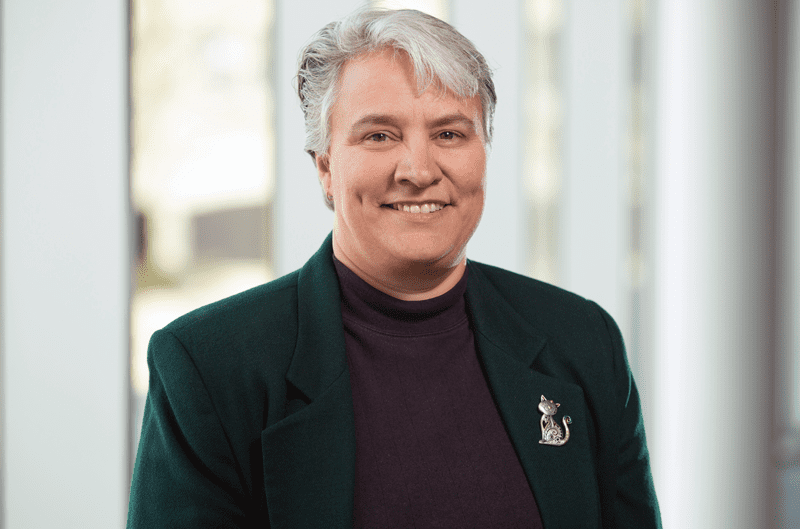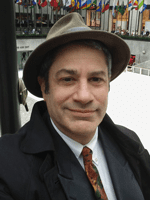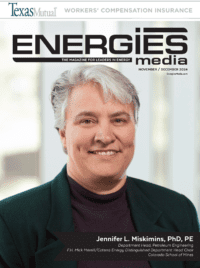At its centennial annual conference September 23-25 in New Orleans, the Society of Petroleum Engineers (SPE) named Jennifer L. Miskimins, PhD, PE incoming president for 2026. She is the F.H. Mick Merelli/Coterra Energy Distinguished Department Head Chair of Petroleum Engineering at the Colorado School of Mines in Golden, and will take the helm of SPE at the next annual conference in Dallas.
A native of the Mountain West, Miskimins had many years of industry experience from roustabout through reservoir and production engineer around the Rockies and Mid-Continent before re-entering academia and rising quickly to leadership at Mines and across the industry.
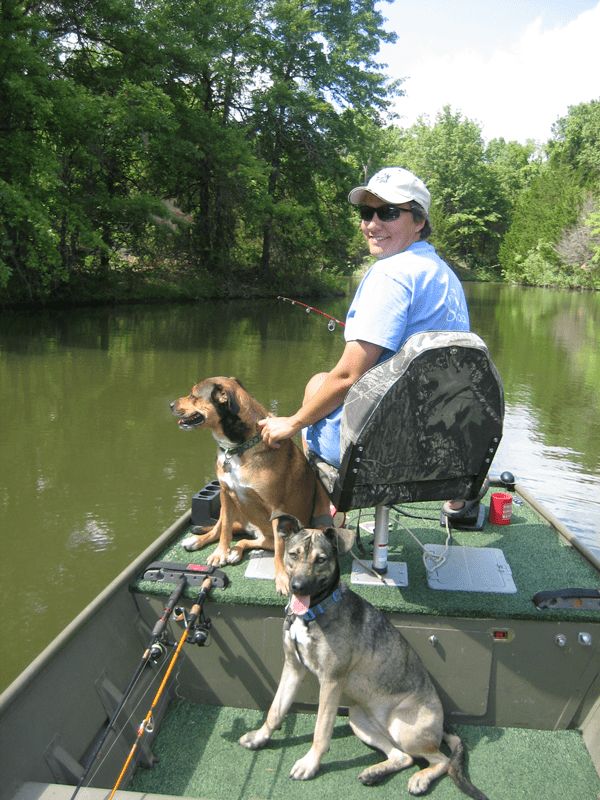
Zoey (gray) joining her. Photos courtesy of Jennifer Miskimins.
Miskimins has the ready smile and relaxed leadership style of the person who has both published papers and run field operations through evolution in technology and multiple commodity cycles. She is equally at home in the classroom and the boardroom, in the lab and on the hiking trail. She started teaching at Mines in 2002 and has held various appointments since then. From 2013-16, she had a part-time appointment at Mines, while working for Barree & Associates, where she specialized in hydraulic fracture design and post-treatment analysis. In 2016, she returned full-time to the university.
When she realized that there were not enough students earning advanced degrees in hydraulic fracturing and stimulation to meet the needs of burgeoning unconventional development, she formed a consortium to address that. Under her leadership, Mines has actively incorporated carbon capture and storage (CCS) into its curriculum.
With a firm foundation in traditional energy, and a vivid vision for energy transition, Miskimins radiates a calm energy of her own. Her enthusiasm for both science and industry is palpable, and she engenders the same in her colleagues and students.
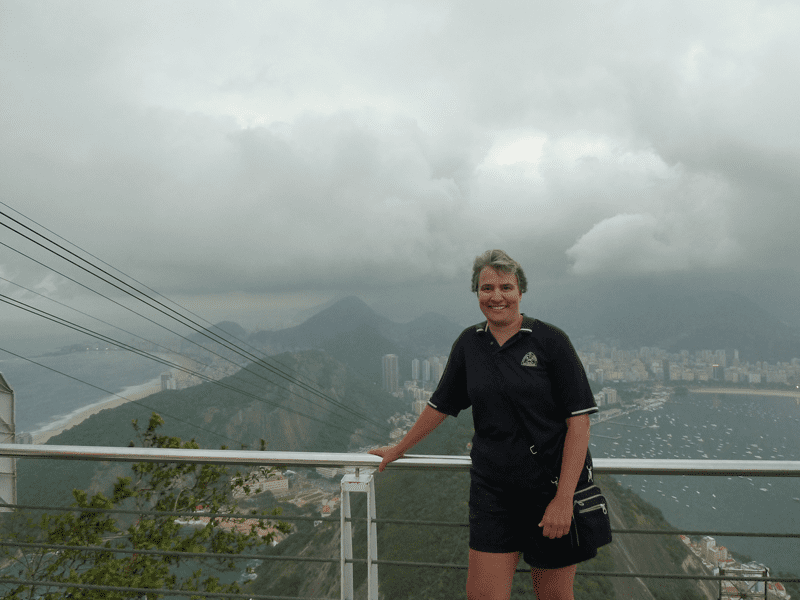
“The mood at the SPE conference was very upbeat,” says Miskimins, “and it was very international, which was wonderful. There were members from Europe and South America, as well as from Africa and Asia, where the association is growing fastest. It’s great that conferences are back in full [swing] after the pandemic. This event had all of the good things: walking the floor, talking to people, seeing the opportunities in the industry. And, of course, New Orleans is a great place, very international, with so much history.”
At the same time, Crescent City is part of the present and the future as an operations hub for exploration and production in the Gulf of Mexico. More broadly, Louisiana has moved to the forefront of CCS because it has a rare proximity of both process industries and sequestration geology. “There were a lot of panels on offshore oil and gas, as well as CCS, hydrogen and geothermal energy,” says Miskimins.
“There was also a lot of discussion about artificial intelligence,” she adds. “We got to go to Shell’s office where they have full digital twins of their offshore operations. It’s one of the centers where they monitor their offshore operations worldwide. It’s exciting to think where the industry is going. We could have fully robotic rigs and get humans out of the safety zone.”
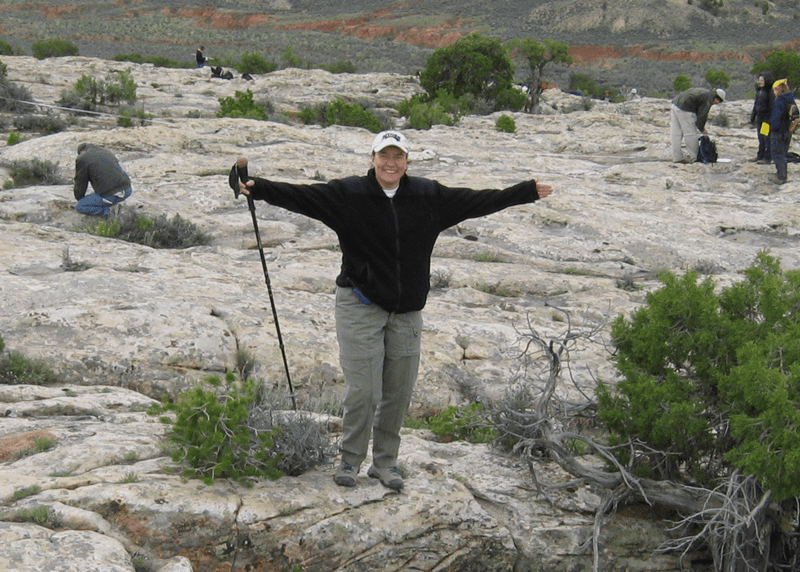
Capturing Carbon – and Opportunity
Under her guidance, Mines has taken a leadership position among major universities in CCS. It was the first major petroleum engineering school to offer a graduate certificate in the subject in 2021, and is actively considering ways to expand the program, including possibly offering a master’s degree. Most petroleum-engineering classes have expanded to offering modules in geothermal and CCS, as well as having specific classes in these areas.
“Petroleum engineering is all about fluid flow in porous media,” says Miskimins. “We are very good at drilling holes and moving fluids into, around and out of the ground. So, CCS and geothermal energy are making use of skills we already teach and use. We have faculty [that has] worked with CO2 for decades. We are absolutely set up to be the CCS university today, and I hope the geothermal university, too.”
Industry is voting with its dollars as well. “We are seeing an increase in our research portfolio for CCS and geothermal,” says Miskimins, “and other programs are seeing similar trends.” That influx means that the ratio for funded research at Mines petroleum engineering is 65% core oil and gas and 35% new energy. “We are also being encouraged to develop data analytics with AI and machine learning,” she adds. “We’ve added faculty in all those areas.”
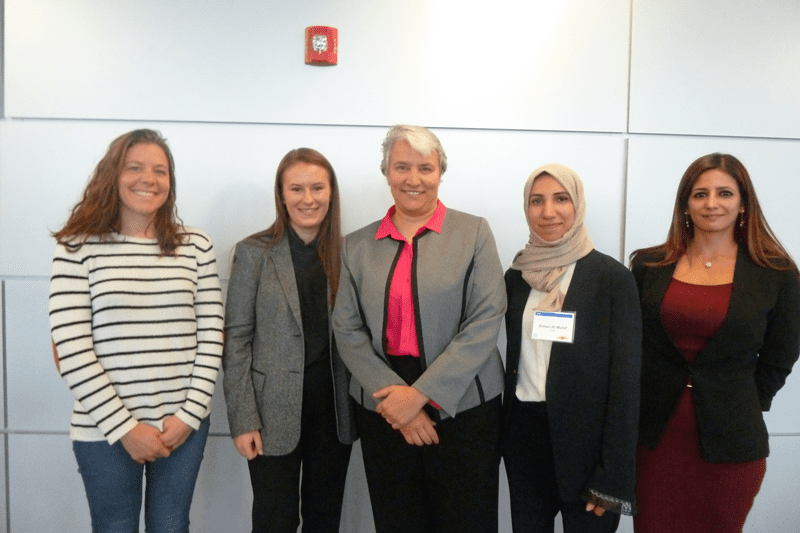
(PhD student). FAST Consortium meeting. 2019.
At the start of the fall semester there were 142 undergraduate students in petroleum engineering at Mines, an increase of almost 12% from the previous year. Graduate student enrollment has also grown. The program celebrated its centennial in 2022 with the opening of a Hall of Fame. The entire university is celebrating the 150th anniversary of its founding this year.
In such a global industry, one element of diversity remains a stubborn challenge: gender. Two decades into the 21st century, Miskimins is the only female head of a major petroleum engineering program in the country. “Gender is still a challenge,” she acknowledges. “We’d love to get more women into the program.”
This year is also the 20th anniversary of the Fracturing, Acidizing, Stimulation Technology (FAST) Consortium, which Miskimins founded.
“When I started teaching full time, I felt that there were not enough opportunities and not enough students coming out with advanced degrees in hydraulic fracturing and stimulation,” Miskimins recalls. “I’m not a basic science person, I am an applied technology person.”
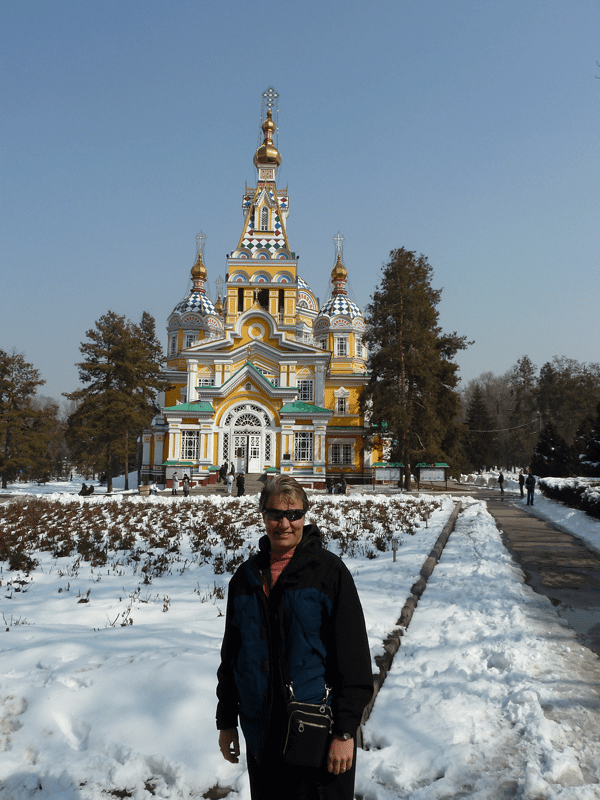
FAST is a joint industry-university research consortium that performs research in all areas of stimulation of oil and gas wells. The consortium concentrates on theoretical and laboratory developments that can be directly employed in the field to improve stimulation design and execution. Full partnership of industry is essential to the success of the consortium, and industry members are encouraged to provide direct input and guidance for the various projects.
Follow the Bouncing Ball
Originally from Wyoming, Miskimins took her undergraduate degree across the state line to Montana because of volleyball. “I knew I wanted to study engineering and was looking at several universities when I got a call from the volleyball coach at Montana College of Mineral Science and Technology. Montana was one of the last states to fully adopt Title IX and, when it did, there was no pool of female athletes for the college programs.”
The summer after her freshman year, she “fell into an internship with Marathon. It was happenstance, but I fell in love with the people and the fieldwork. I was a roustabout painting wellheads and things like that. I applied for the petroleum engineering program at the start of my sophomore year.”
After graduating, Miskimins went back to work for Marathon and returned to her home state. “I was a production engineer based in Cody. The majority of the time, I was in the Grass Creek field outside of Thermopolis [home of the Wyoming Dinosaur Center]. I did my own workovers and sat on my own rigs. Overseeing day-to-day work was like its own little world.”

“Then I went to Lamar, Colorado, [to] the old TXO properties in Colorado and western Kansas, where I was doing my own geology, and I was my own landman in addition to the engineering. I was also in Lafayette, Louisiana, as a reservoir engineer for a while. Those years of industry experience in the field were the best education I ever got, but I decided I was ready to try the academic side of things.”
That broad and deep time in the field continues to inform her approach to teaching and running the department. “I cannot stress industry experience enough to our students,” Miskimins says. “It’s one thing to look at an equation on the page, but understanding how things work in the field makes all the difference.”
With five offers in hand from grad schools, three in petroleum engineering and two in chemical engineering, Miskimins chose Mines. “It was the best program for me. There were people on staff who were specializing in the areas that I wanted to study. It was serendipity: the time, the place, the people.”
In her own time and place, many of her people are animals. “I have horses, dogs, cats and chickens,” Miskimins says. “They are my sanity. I love to get away into the mountains to fish, hike and camp. I also play golf, but not enough to have a handicap,” she says with a laugh.
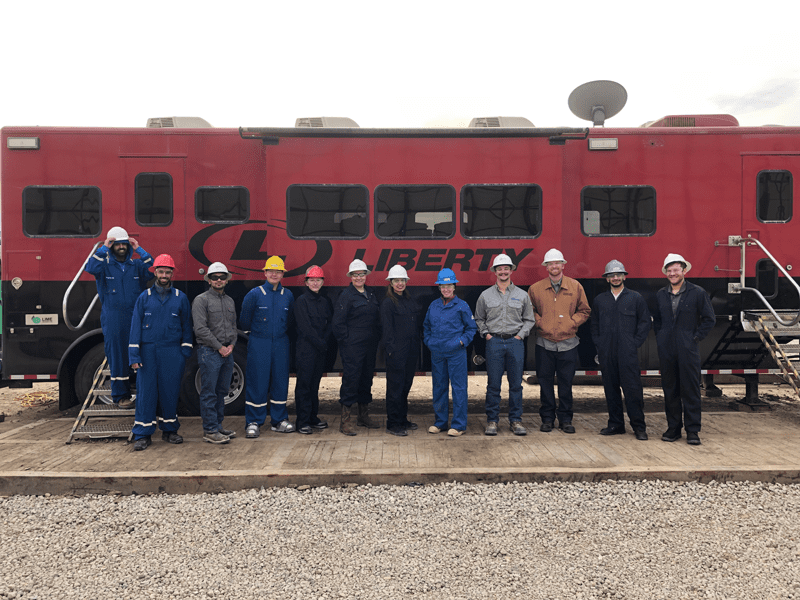
Next Gen Level Excitement
Travel is another passion for Miskimins. “I’ve been very lucky in that I have had the chance to visit over 40 different countries. That is one of the great things about the industry. The most beautiful place I have ever been is New Zealand. The people and the scenery are just wonderful. The most exotic place I’ve been is probably the Galapagos Islands.”
Looking ahead, Miskimins would like to visit Southeast Asia, particularly the legendary temple complex of Angkor Wat in Cambodia. “I would also like to take a safari in Africa to see the amazing animals.”
She has an equally ambitious vision professionally. “It’s exciting to see what the industry will become. Getting the next generations excited about the industry is about showing them how modern we are. It’s AI and drilling in 10,000 feet of water. There is a tremendous opportunity to provide the energy that the world needs – and I mean all the kinds of energy. Clean energy needs bright minds.”
To that end, Miskimins laments the way industry has long closed itself off. She advocates for changing that mindset through her academic and professional leadership. “We have to be our own advocates,” she urges. “SPE is not a lobbying organization – it’s a professional society – but part of that is advocating for the profession. We have to be able to have those tough conversations, be it with family members, or neighbors, or anyone.”
SPE has a website, Energy4Me.org, that includes lesson plans for elementary through high school teachers in both the U.S. and Canada.
Petroleum engineering research at Mines is balanced among basic and applied research with an emphasis on field work, all natural expressions of the leader’s experience and outlook. “That is not unique,” Miskimins points out, “but it is unusual. It is driven in large part by our loyal alumni.”

Select Mines Alumni (B.S. in Petroleum Engineering)
Andrew Haney, 2001
Cofounder and Co-President Nickel Road Operating
Andrea Wescott Passman, 1998
COO Aethon Energy
David Lawler, 1990
CEO Kimmeridge Texas Gas
Mines Board of Trustees (2022-2025)
Robert D. (Doug) Lawler, 1988
President & CEO Continental Resources
John J. Christmann, IV, 1988
CEO APA Corp.
Robert E. McKee III, 1968
EVP Exploration & Production Conoco
Steve Chesebro’, 1964
Former President & CEO
PennzEnergy, Former Chairman Harvest Natural Resources
Cofounder Natural Gas Council
Source: Colorado School of Mines
Headline photo courtesy of Colorado School of Mines Marketing Department.
Gregory DL Morris is an independent business journalist and historian. He is principal and editorial director of Enterprise & Industry Historic Research and co-author of A History of the Theatre Costume Industry (Routledge, 2022). Morris is North American Editor for Speciality Chemicals magazine. Before that, he was Gulf Coast bureau chief and global markets editor for ChemicalWeek, executive editor of Bank Investment Marketing, and editor in chief and associate publisher of Today’s Refinery. He has reported from all 50 states, eight Canadian provinces, and 17 countries on five continents. Morris is a member of the Editorial Board of the Museum of American Finance, a Smithsonian affiliate. He is a second-generation member of the Overseas Press Club, and second-generation Eagle Scout. Morris earned a bachelor of science from Cornell University in journalism and education, with distinction in all subjects.

